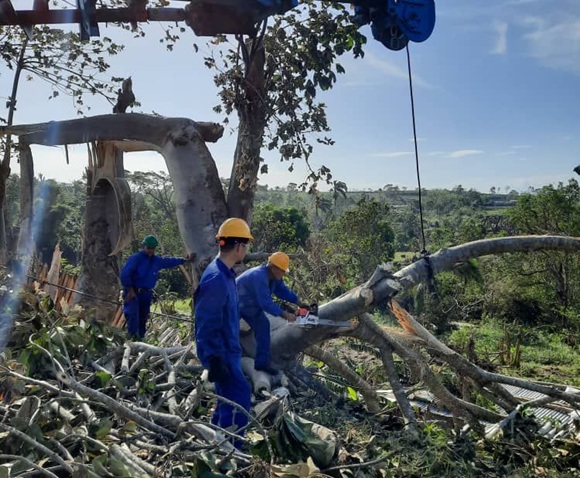By René Tamayo
The expanded National Defense Council continued its systematic monitoring this Monday of the progress of the work to repair the damage caused by Hurricane Melissa in Guantánamo, Santiago de Cuba, Granma, and Holguín provinces. The restoration of electricity, water supply, telecommunications, and other basic services is progressing, but much remains to be done for residents to return to their daily lives.
The exchange, held via videoconference with authorities from the affected territories, was led by the First Secretary of the Central Committee of the Communist Party and President of the Republic, Miguel Díaz-Canel Bermúdez, President of the National Defense Council (CDN). It was moderated by Political Bureau member and Prime Minister Manuel Marrero Cruz.
The restoration of electricity service in the eastern region was one of the topics extensively discussed. The Minister of Energy and Mines, Vicente de la O Levy, reported that in Las Tunas, service has been restored to 99.95 percent of customers; in Guantánamo, 96.45 percent; in Holguín, 79.76 percent; and in Granma, 73.44 percent.
The restoration of electricity in Santiago de Cuba has reached 29.23 percent, a still low figure due to the extensive damage to the distribution lines and the complexity of their rehabilitation. Therefore, the greatest efforts are being concentrated in this province.
As he explained, all substations in the province should be energized by the National Electrical System (SEN) within the next few hours, which will allow for a significant improvement in service.
A priority for the electrical workers is the municipality of Santiago de Cuba, with 187,000 customers, where damage to distribution lines is extensive due to fallen trees, causing serious damage to poles, power lines, and other infrastructure.
In response to a question from the Cuban President, the Minister of Energy and Mines explained that 100% of customers in the Hero City should have their service restored this week. The situation is also complex in other municipalities, but all will experience a certain level of service starting this Tuesday thanks to the energization of the substations.
Santiago de Cuba is a priority for electrical workers; brigades from other provinces will continue to arrive to support the efforts. Currently, 3,746 workers are working on the power lines in the eastern region, and more personnel will continue to be deployed to Santiago de Cuba.
In the municipality of Guamá, Vicente de la O Levy explained, the distributed generation unit that was relocated there is already installed and operational.
Work continues tirelessly on the Báguanos-Bayamo distribution line, where six high-voltage towers were downed by the hurricane, including the use of FAR (Revolutionary Armed Forces) equipment due to the difficult access caused by the damage left by Melissa.
In Holguín, it is estimated that very few customers will remain without service by the beginning of next week; in Granma, the seven flooded substations have been repaired, and the Río Cauto substation is already being brought online.
In this province, a six percent increase in service is expected in the coming hours; in Guantánamo, the main limitations are in the mountains and isolated areas.
Water Supply and Other Services
Regarding the water supply, the president of the National Institute of Hydraulic Resources, Antonio Rodríguez Rodríguez, commented that all the infrastructure in Las Tunas has been restored.
In Holguín, 83 percent of people are receiving water service through their usual channels; in Guantánamo, 96 percent; in Granma, 55 percent; and in Santiago de Cuba, 57 percent; 45 percent through the main water network and the rest by water trucks.
In Holguín, work is underway on the water mains, including the construction of a new 9.5 km pipeline and the repair of others. Equipment is also being installed that will allow for increased water supply, both here and in the rest of the province.
In Santiago de Cuba, for example, the work carried out on the Quintero 1 and 2 pipelines will increase the water flow by more than 1,500 liters per second, exceeding the flow rate before Tropical Storm Melissa.
At Monday’s meeting of the National Defense Council, the subgroups of the Economic and Social Body also reported. In the Food sector, the Minister of Domestic Trade, Betsy Díaz Velázquez, commented on ensuring the supply of rice, a staple food, among other products, for residents of the provinces hardest hit by the hurricane.
It was also reported that 21 tractors and other equipment had been sent to support agricultural recovery in Santiago de Cuba, as well as chainsaw attachments being used to cut down fallen trees.
In the affected areas, some 13,000 hectares of crops, such as plantains, cassava, and coffee, have been recovered.
The meeting, which included representatives from the provincial defense councils of Guantánamo, Santiago de Cuba, Granma, and Holguín, also featured reports from the Transportation, Industry, Health, Education, and International Cooperation groups, among others.
It was also reported that tens of thousands of roofing materials, such as cement and zinc roofing tiles, and other construction materials, were being made available to the affected territories.
IMAGE CREDIT: Electricians and telecommunications workers from Villa Clara restore services in eastern Cuba after Hurricane Melissa. Photo: Radio Rebelde.
[ SOURCE: CUBA DEBATE ]

